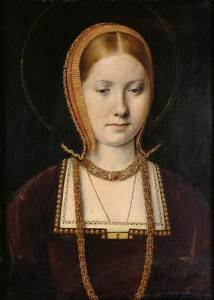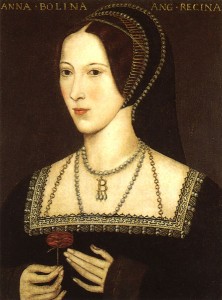I am delighted to be hosting Day 1 of Amy Licence‘s blog tour for her latest book, Catherine of Aragon – An Intimate Life of Henry VIII’s True Wife. To celebrate this wonderful book’s release, I have an extract from the book to share with you about Henry VIII meeting and falling in love with Anne Boleyn.
Happy reading!
Had circumstances been different, the dark-eyed fascinating Anne Boleyn might have simply become another one of Henry’s mistresses, like her sister Mary had been. She may even have been his first maîtresse-en-titre, a title the king offered her inspired by the court of his rival Francis I. Perhaps she would have reigned at court for half a dozen years, borne a couple of illegitimate children and died in a comfortable old age. But by the time Henry fell in love with her in 1526, Catherine’s child-bearing days were over and he had already made the decisive mental leap to reject his wife and queen and replace her with a younger, fertile model.
Anne’s charms were probably the final proof he required to convince himself that Catherine was not his legal wife and that they had been living in sin for seventeen years. Perhaps Anne’s will and ambition were also a driving force in this monumental shift; the hostile Richard Pole certainly thought so, claiming that the experience of her sister had taught Anne how “fleeting” the king’s affections were, so “she herself sent her chaplains, grave theologians, as pledges of her ill… not only to declare to (Henry) that it was lawful to put (Catherine) away but to say that (he) was sinning mortally to keep her as (his) wife even for a single moment.” After some initial reluctance, personified by the silver statue she sent Henry of a woman in a ship tossed on stormy seas, Anne was as keen for the marriage to take place as Henry was. Yet ultimately, it would not have happened had it not been the king’s will….
It is not clear exactly when Catherine become aware that Henry was intending to replace her with Anne Boleyn. It may have been as early as the summer of 1527, perhaps in August, when Henry applied for a dispensation to remarry, although no new wife is specifically named. Or it may have been the following February, when the Venetian ambassador became aware of her existence, writing that Henry was repudiating Catherine because the dispensation covering her initial marriage to Arthur was “defective and invalid” and intended, “for the maintenance and welfare of his realm” to wed “Thomas Boleyn’s daughter, who is very beautiful”. After eighteen years of marriage, Catherine must have become adept at reading her husband’s moods and observing the development of his affairs, but lately she had been denied the kind of intimate access to him that would have enabled her to interpret and influence him. Early on in the marriage and again, with the elevation of Henry Fitzroy, she had been reminded by Henry that he would not tolerate her commenting upon certain aspects of his personal life and, if Wolsey’s biographer Cavendish is to be believed, she had learned to keep her enemies close, almost to appreciate them, holding Anne in “great estimation” and accepting “all things in good part and with wisdom and great patience.” She had weathered the storm thus far and would refute these allegations with obstinate certainty. As an anointed queen, stepping aside to enter a convent was insult enough; leaving the throne empty for her lady-in-waiting was unthinkable. Catherine was the daughter of two monarchs, with Plantagenet blood in her veins and connected to the great ruling houses of Europe; Anne was the descendent of a merchant. There was also the question of religion and the supremacy of the church. Catherine represented the old faith, with its Catholic ritual and the guidance of papal authority: Anne’s background was reformist, “more Lutheran than Luther himself.” She leaned towards France rather than Spain and the Holy Roman Empire. Thus, she represented a threat to the entire world that had produced and nurtured Catherine, which she had proudly represented for decades. Anne must not replace Catherine. Such a move would redefine England.
About the Author
 Amy Licence is a journalist, author, historian and teacher, currently living in Canterbury, Kent, UK. Her particular interest lies in the fifteenth and early sixteenth centuries, in gender relations, queenship and identity, rites of passage, pilgrimage, female orthodoxy and rebellion, superstition, magic, fertility and childbirth. Other interests include the Bloomsbury Group and Modernism, specifically the Post-Impressionists and Cubism. Amy’s favourite authors are Shakespeare, Austen, Woolf, Plath, Zola, T.S.Eliot, Nabokov and Dostoevsky. She is also an admirer of Mozart and Picasso, the Renaissance and the Baroque.
Amy Licence is a journalist, author, historian and teacher, currently living in Canterbury, Kent, UK. Her particular interest lies in the fifteenth and early sixteenth centuries, in gender relations, queenship and identity, rites of passage, pilgrimage, female orthodoxy and rebellion, superstition, magic, fertility and childbirth. Other interests include the Bloomsbury Group and Modernism, specifically the Post-Impressionists and Cubism. Amy’s favourite authors are Shakespeare, Austen, Woolf, Plath, Zola, T.S.Eliot, Nabokov and Dostoevsky. She is also an admirer of Mozart and Picasso, the Renaissance and the Baroque.
Find out more about Amy Licence at her website.
Buy a copy of Catherine of Aragon: An Intimate Life of Henry VIII’s True Wife
Amazon US (Available for pre-order)




















Wonderful article from what im sure will be a fascinating book. Amy’s research is done so meticulously that her books are very informative and enjoyable to read.
I find Catalina de Aragon fascinating! I watched a spanish tv series about Isabel and Fernando (“Isabel” RTVE) and it seems to me like she was very much like her mother: a woman full of conviction and will. I’ll look for this book, thanks!